Public Parks in Dubai: Community, Culture, and Nature
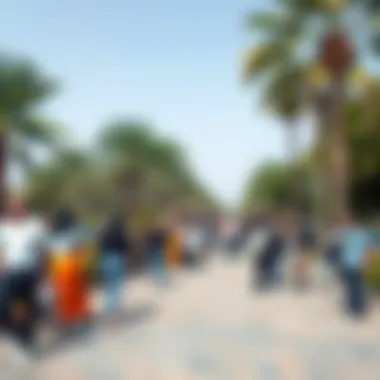

Local Culture and Community
Public parks in Dubai hold a unique space in the fabric of the city, fostering a sense of belonging among its diverse residents. As the city burgeons, these green oases not only beckon tourists but also serve as essential spaces for locals to connect with one another. Parks facilitate cultural interactions, revealing layers of Dubai's identity, from heritage to modernity.
Cultural Festivals and Events
Many public parks in Dubai become vibrant platforms for cultural festivals and community events. For example, Al Barsha Pond Park frequently hosts events during Dubai Shopping Festival, where local artisans showcase their crafts and culinary delights, allowing residents and visitors to immerse themselves in the emirate's rich cultural tapestry. These gatherings create opportunities for social bonding and highlight local traditions amidst a backdrop of lush greenery.
In parks like Zabeel Park, the annual Dubai International Peace Convention draws in crowds eager to engage in discussions centered around unity and tolerance, which are core to Dubai’s ethos. This blend of natural beauty and cultural celebration fosters communal ties and nourishes the spirit of cooperation and understanding.
Community Engagement and Activities
Community engagement within park settings is also evident through various organized activities. From weekend yoga classes in Safa Park to family fitness events in Mushrif Park, there’s always something happening. These activities not only promote wellness but also bolster social interaction. On any given Saturday, one might find families picnicking alongside groups practicing tai chi, all contributing to a lively atmosphere.
The success of such events isn’t merely a product of the calendar but a reflection of a broader desire for interaction among the city’s multifarious population. The UAE's emphasis on societal well-being is embodied in these moments of shared joy and communal passion.
"Dubai’s parks are more than just green spaces; they are the beating heart of our community life. They invite people to gather, share, and learn from one another."
Lifestyle and Amenities
Public parks do not only provide recreational avenues; they are also peppered with lifestyle amenities that enhance the urban living experience.
Dining and Culinary Experiences
A stroll through parks like Dubai Marina’s Jumeirah Beach Park reveals an array of dining options, from casual food trucks serving up local fare to upscale restaurants with sweeping views. The interconnectedness of nature and gourmet experiences transforms a simple outing into a leisurely exploration of culinary delights.
Food festivals in parks also work to reintroduce traditional Arabic flavors, allowing both residents and visitors to relish the authenticity of Dubai’s gastronomy. The experience extends beyond just eating; it can be about learning the story behind each dish and understanding the cultural roots that influence every meal.
Recreational and Entertainment Options
In addition to dining, there are countless recreational options available within these parks. Many facilities cater to fitness enthusiasts — paths for running, cycling lanes, and dedicated exercise stations are peppered throughout. Parks like Al Khazzan Park are particularly family-friendly, showcasing playgrounds that provide safe havens for children to engage in unstructured play while parents take a breather.
Further afield, Dubai Safari Park introduces a more immersive experience, blending wildlife conservation and education, which appeals to families looking for enriching recreational activities. Meanwhile, artsy nooks in Al Fahidi Historical Neighborhood offer a blend of culture and serenity, fostering spaces where art lovers can gather and reflect.
For more information on David's Urban Park initiatives, check out resources like Dubai Government's official site and the insightful articles on Britannica.
The Role of Public Parks in Urban Life
Public parks serve as the green lungs of any urban environment, and in the rapidly developing city of Dubai, their significance cannot be overstated. With soaring skyscrapers and bustling streets, it is vital to have spaces where residents and visitors alike can breathe and unwind. Parks play a pivotal role in enriching urban life by providing not just recreational opportunities but also contributing to physical and mental well-being.
One facet that stands out is the role of parks in fostering community engagement. These green spaces become lively hubs where families gather for picnics, friends meet for leisurely strolls, and children enjoy playtime free from the cacophony of city life. Parks create a sense of belonging, allowing people to forge connections with their neighbors and forge shared experiences. This aspect is particularly poignant in a multicultural city like Dubai, where diverse backgrounds converge.
Additionally, parks provide a much-needed respite from the heat of the desert. Shade from trees, cool breezes, and expansive lawns create an inviting atmosphere. In high temperatures, parks become even more crucial, as they offer cooling spots where people can recharge, similar to an oasis in the bustling urban landscape.
Ecologically, these parks contribute to the sustainability of the urban environment. They help mitigate heat island effects by providing cooler areas and supporting biodiversity through native plants and wildlife, which, in turn, contributes to improved air quality. The tranquility of greenery offers a stark contrast to the constant noise of cars and construction, allowing individuals to feel more peaceful and centered.
Defining Urban Parks
Urban parks can be defined as green spaces situated within city areas designed primarily for recreation and relaxation. Unlike botanical gardens or large wildlife reserves, they tend to be more accessible and integrate features such as walking paths, playgrounds, and open fields. They are multifunctional zones that cater to the needs of the local population, whether that is through exercise, social gatherings, or enjoying nature.
Dubai’s urban parks often blend innovative design with traditional elements, presenting a unique space that caters both to leisure and cultural identity. From landscaped gardens to vibrant community spaces, these parks are reflections of the city's commitment to creating healthier living environments for its residents.
Historical Context
Historically, the concept of public parks in Dubai is relatively young, emerging as the city transformed from a small fishing and pearl diving village into a sprawling metropolis. Initially, public spaces were quite limited, shaped by the harsh desert climate and the effective use of resources.
As Dubai started its ambitious development projects in the late 20th century, the recognition of the need for public parks grew. With the rapid influx of expatriates and a growing population, officials began to understand that parks would not only beautify the city but also enhance the lifestyles of its residents.
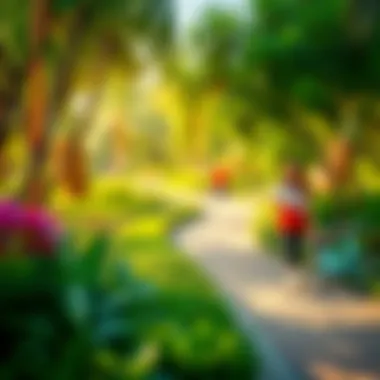
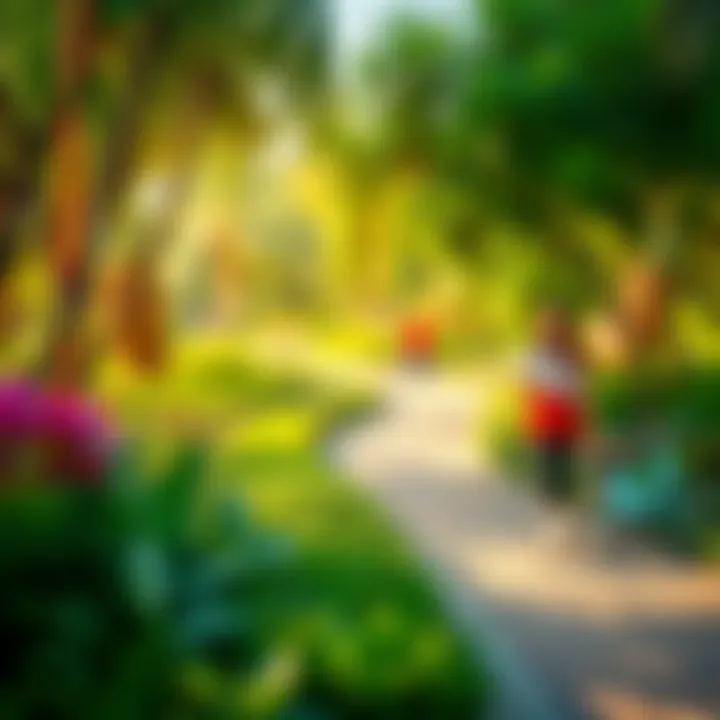
The government made strides to incorporate public parks into its urban planning, integrating sustainability with accessibility. Starting from the early 2000s, initiatives like the creation of Safa Park and Zabeel Park highlighted a shift in focus towards creating recreational spaces suited for communities. Over the years, Dubai has continued innovating its parks, making them not just a luxury but a necessity for urban living.
Characteristics of Public Parks
Public parks serve multiple purposes that extend beyond mere patches of greenery in urban settings. They are vital components of urban infrastructure, contributing significantly to the quality of life in cities like Dubai. Understanding the characteristics of these parks is essential for grasping their multifaceted roles in community life, environmental health, and cultural expression.
Design Elements
The design of a public park is not just about aesthetics; it's about creating spaces that meet the diverse needs of its users. Parks in Dubai often feature a blend of modern and traditional design elements, balancing functionality with beauty. You’ll find paths that are not just for walking; they encourage cycling, jogging, and even rollerblading.
In terms of landscaping, many parks incorporate native plants which not only thrive in Dubai's arid climate but also support local wildlife. Think of how Zabeel Park integrates both open green areas and shaded spots provided by trees, creating a microclimate for park-goers.
Facilities such as playgrounds, fitness stations, and picnic areas are often thoughtfully positioned to maximize accessibility and promote social interaction. Public art installations are also becoming more common, serving as focal points that reflect the community’s values and initiatives. These elements together create inviting environments where families can gather, individuals can find solitude, and everyone has a space for leisure and recreation.
Indeed, parks in Dubai aim to be multifunctional. They need to accommodate events like festivals or markets without losing the essence of tranquility that a green space offers. For instance, Mushrif Park offers an extensive area for more organized community gatherings whilst maintaining serene spots away from the bustle.
Accessibility and Inclusivity
Accessibility and inclusivity are crucial when discussing urban parks. In a multicultural city such as Dubai, parks must cater to a diverse population. This means ensuring that all facilities, sidewalks, and paths are accessible to individuals of all abilities. Ramps, clearly marked paths, and braille signage can make a world of difference. People with mobility impairments or those with small children in strollers should find it easy to navigate these public spaces.
Moreover, inclusivity also extends to design choices that reflect the cultural diversity of the community. Parks can serve as cultural hubs where different backgrounds and traditions converge. For example, areas where people can perform traditional dances or hold cultural events encourage participation from all demographics, fostering a sense of belonging.
Additionally, the programming of parks plays a pivotal role in inclusivity. By hosting various activities, from yoga classes to art exhibitions, parks become platforms for everyone to engage, connect, and learn from one another.
"A well-designed park is one that welcomes all citizens, reflecting the tapestry of the community while ensuring that everyone finds their place within it."
In summary, the characteristics of public parks in Dubai are tailored to create environments that are not only visually appealing but also accessible and welcoming to everyone. Engaging design elements combined with a commitment to inclusivity lay the foundation for parks that enrich community life and support environmental stewardship.
Cultural Significance of Parks in Dubai
Parks in Dubai are not merely patches of greenery amidst the concrete jungle; they serve as vital community hubs. In a city marked by rapid urbanization and cultural evolution, these green spaces play a pivotal role in shaping social interactions and local identity. Public parks foster connections among residents, bridging diverse cultures and backgrounds. Someone visiting a park might find families enjoying picnics, friends playing sports, or even individuals engaging in quiet reflection. This representation of life brings the community together, highlighting the way parks can unite people across various walks of life.
Parks as Community Gatherings
Public parks in Dubai function as bustling centers of community life. They offer a place for people to socialize, engage in recreational activities, or simply unwind after a long day. Take Zabeel Park, for instance. It is not just a park; it’s a vibrant arena where families gather, children play, and fitness enthusiasts come together. The setting encourages picnics, cultural events, and even festivals. During the cooler months, weekends see many families flocking to the park, bringing their traditional dishes and celebrating their heritage amidst the foliage.
Moreover, these parks support community health. They provide spaces for physical activities, such as jogging or yoga, which foster both physical well-being and social connection among residents. Individuals who may not have met otherwise cross paths here, fostering new friendships and encouraging a sense of belonging. In this regard, parks serve more than recreational purposes; they become crucibles of community bonding.
Reflecting Local Heritage
The design and layout of Dubai's public parks often echo the city's rich cultural heritage and history. For example, as one strolls through Mushrif Park, they encounter elements that pay homage to the traditional Bedouin lifestyle. The park hosts native flora that is significant to Emirati customs and history, reminding visitors of the region’s roots. It is a direct reflection of how the city values its past while embracing rapid modernization.
Additionally, parks serve as venues for cultural events and educational programs that promote local traditions, such as poetry readings, art exhibitions, and traditional dance performances. By hosting these activities, parks actively contribute to cultural preservation and education. Events like the Dubai Food Festival often feature stands and events in public parks, turning them into lively showcases of local culinary arts and traditions.
As parks continue to integrate local culture into their spaces, they become not just places for leisure but also classrooms of local history and identity. In a world where globalization is omnipresent, these parks offer a much-needed connection to the cultural roots that define the community’s character.
"Parks in Dubai are not simply green spaces; they symbolize the unity and rich cultural heritage of a community, merging the old with the new."
In all, the cultural significance of parks in Dubai cannot be overstated. They are essential to fostering community spirit, promoting cultural heritage, and enhancing the quality of urban life. As Dubai continues to evolve, these parks remain steadfast beacons of community engagement and cultural expression, ensuring the spirit of the city is not lost amid its rapid development.
Prominent Parks in Dubai
Public parks in Dubai represent not just green oases amidst the towering constructions but serve as essential conduits for social interaction, leisure, and cultural activities. Each prominent park offers unique features that enrich the urban landscape and enhance the quality of life. Understanding these parks is key not just for residents and expatriates, but also for tourists and city planners looking to navigate the dynamic urban environment.
Zabeel Park
Zabeel Park stands as a pivotal green space, offering tranquility and recreation in the heart of Dubai. Spanning over 47 hectares, it is intricately designed with lush landscapes, walking paths, and recreational areas. The park is notable for the Dubai Frame, an architectural marvel that links Dubai's past with its futures. This unique feature not only serves as a visual spectacle but also offers panoramic views of the city.
Moreover, Zabeel Park is equipped with facilities such as open-air theaters, children's play areas, and a designated area for picnics, making it a family-friendly destination. Activities like cycling and jogging are well-supported due to the extensive paths. The park also hosts numerous cultural events throughout the year, reflecting Dubai's diverse population and fostering a sense of community. The availability of facilities like restaurants and cafes ensures that visitors can enjoy refreshments while soaking in the natural beauty of the surroundings.
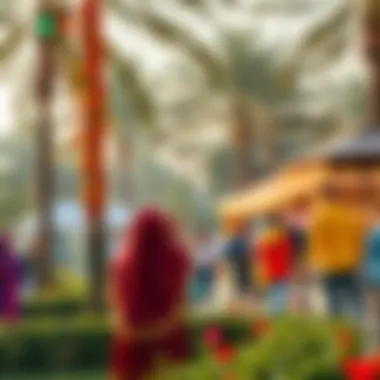
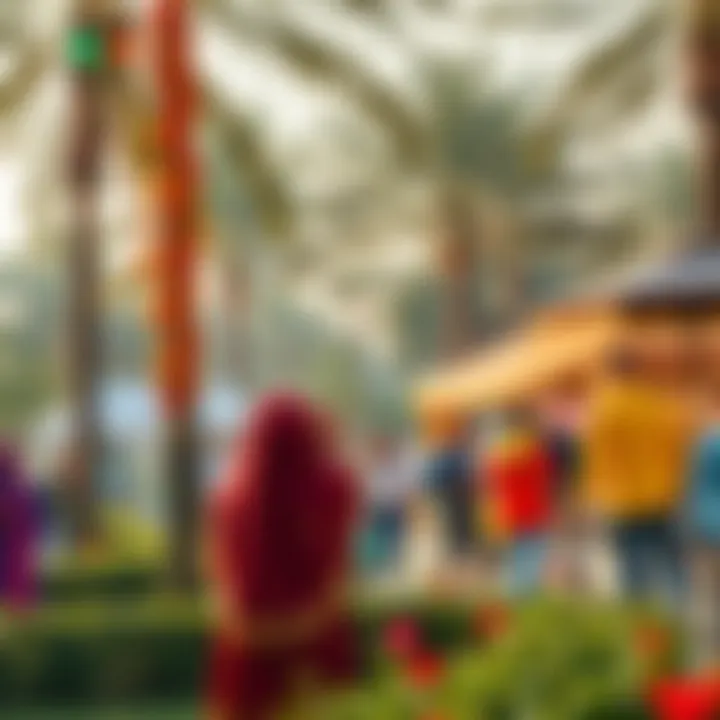
Mushrif Park
Mushrif Park presents an entirely different essence, characterized by its natural desert landscape complemented by a rich variety of flora and fauna. Covering about 5.25 square kilometers, the park is home to various species of trees, making it a hub for biodiversity in an urban setting. One of its standout features is the International Village, where visitors can experience cultural architecture from across the globe, reflecting Dubai's cosmopolitan spirit.
Walking trails wind through the diverse habitats, making it an ideal spot for nature walks and exploration. Unique to Mushrif is its horse and camel riding facilities, a nod to the region's heritage. The park also includes a dedicated space for barbecue, allowing families and friends to gather and enjoy the outdoors. The blend of natural beauty and recreational facilities makes Mushrif Park a vital green space for both relaxation and cultural enrichment.
Safa Park
Safa Park is another prominent green space, ideally situated along the banks of the Dubai Water Canal. This park is a cherished retreat that promotes physical health and social interactions. With over 1500 palm trees and manicured lawns, the park provides a picturesque environment for various outdoor activities. Running tracks, cycling paths, and fitness zones encourage an active lifestyle among its visitors.
Moreover, Safa Park holds a unique cultural significance as it often plays host to events, farmers' markets, and community programs that bring people together. The park features art installations that celebrate local artists, enriching the cultural tapestry of Dubai. Its central location and wide range of activities make it a popular choice for both residents and tourists. With essential amenities like cafes and open spaces for picnics, Safa Park stands out as a versatile destination for everyone.
"Public parks play a crucial role in the societal and environmental fabric of urban settings, and Dubai’s parks exemplify this by fostering community spirit and ecological awareness."
Environmental Benefits of Urban Parks
Public parks are far more than just patches of greenery scattered about a city. They play a crucial role in enhancing urban environments, particularly in a bustling metropolis like Dubai. These green spaces serve as essential lungs for the city, providing myriad environmental benefits that are integral to sustainable urban living. As Dubai continues to expand at a rapid pace, focusing on the environmental benefits of urban parks has never been more relevant. Their contributions to biodiversity, air quality, and overall urban ecosystems cannot be overstated.
Biodiversity and Ecosystem Support
Urban parks act as sanctuaries for various plants and animals, crucial for maintaining biodiversity in cities. Even in a concrete jungle like Dubai, these parks support a surprising range of flora and fauna. For instance, parks like Mushrif Park are home to native species that thrive in the region's climate.
- Habitat for Wildlife: Local wildlife, including birds, insects, and small mammals, find refuge in parks. These habitats not only provide a needed home for these creatures but also help sustain ecological balances. The presence of parks may encourage biodiversity, allowing organisms to interact with each other and with the wider ecosystem.
- Facilitating Pollination: Parks offer essential corridors for pollinators such as bees and butterflies. These creatures help in the pollination of plants, which is key for food production and the general health of the ecological community. This is especially critical in a desert environment where pollination can be scarce.
- Soil Health: Green spaces contribute to the improvement of soil health by promoting the growth of native plants. Their root systems stabilize the soil, reducing erosion and increasing its fertility. The presence of diverse plant species encourages a healthy soil microbiome, creating a thriving ecosystem that benefits both plants and urban dwellers.
With the introduction of native and adaptive species, parks can foster thriving ecosystems, turning mere patches of grass into vibrant ecological communities.
Air Quality Improvement
Air quality enhancement is one of the most pressing environmental benefits associated with urban parks. In a city where development and growth often compromise air quality, these green spaces serve as vital filters.
- Pollutant Absorption: Trees and plants in urban parks absorb pollutants like carbon dioxide, nitrogen oxides, and sulfur dioxides, making the air cleaner to breathe. Through photosynthesis, plants convert CO2 into oxygen, playing a crucial role in combating air pollution, which can be severe in cities with heavy traffic like Dubai.
- Temperature Regulation: Parks help mitigate the urban heat island effect—a phenomenon where urban areas are significantly warmer than their rural surroundings. By providing shade and releasing moisture into the atmosphere through transpiration, parks lower local temperatures, which in turn reduces energy consumption in nearby buildings and homes.
- Improving Public Health: Better air quality directly correlates with improved public health outcomes. Clean air reduces respiratory problems and cardiovascular diseases, contributing to a healthier population. In Dubai, where the heat can be difficult to bear, parks provide cooler, cleaner spaces for relaxation and recreation.
The interplay of parks and urban air quality is critical. As we think about the future of urban planning, integrating more green spaces into the city can profoundly impact the health and well-being of its inhabitants.
A commitment to maintaining and expanding public parks is not just about landscaping—it's about fostering a healthier, more sustainable urban ecosystem.
With the ongoing challenges of urbanization, prioritizing the environmental benefits of public parks significantly impacts Dubai's quality of life, making a greener future attainable.
Challenges in Maintaining Public Parks
Public parks in Dubai are not just patches of greenery; they represent a collective investment in the community's well-being and environmental health. Nevertheless, maintaining these spaces comes with its own set of hurdles. Fund allocation, ecological balance, local engagement, and infrastructural advancements all play critical roles in ensuring these parks serve their intended purpose without becoming a burden. Without addressing these challenges, the parks might lose their charm and function, alienating residents and visitors alike.
Funding and Resource Allocation
One of the primary obstacles faced in the maintenance of public parks is funding. Managing lush green spaces requires persistent contributions, both in financial terms and human resources. Though the Dubai government recognizes the vital role these parks play, inconsistent budgets often lead to inadequate maintenance. Without sufficient funds, basic tasks like landscaping, tree care, and installation of facilities can fall by the wayside.
- Public vs. Private Funding: Government budgets can be tight, compelling parks to rely more heavily on private sponsorships. This might lead to commercialization, where parks cater around financial backers’ interests rather than community needs.
- Effect on Maintenance: Lack of funds means fewer staff members tending to the park's upkeep; fewer hands make light work, as they say. A tangled mess of unkempt trees, littered paths, or inadequate restroom facilities can drive visitors away.
While trying to secure funding, officials also need to consider the economic landscape of the city. Raising general awareness on the value of parks may help anchor more support. People need to realize that these green spaces are, in fact, foundational for societal health.
Balancing Development and Preservation
Dubai’s rapid development may bring skyscrapers that reach for the wind, yet this ambition sometimes overshadows the humble yet essential presence of public parks. Striking a balance between growth and preservation is like walking a tightrope. It's imperative to integrate parks into the ongoing urban landscape rather than treat them as afterthoughts.
- Urban Planning: Smart city planning can help by embedding greenery into future architectural schemes. This means ensuring that parks complement residential and commercial spaces, creating harmonious environments instead of isolated patches.
- Ecosystems at Risk: As buildings rise, local flora and fauna face threats. New projects often lead to the destruction of existing ecosystems which parks are designed to protect and celebrate. If urban planners don’t strategize wisely, they might destroy habitats even as they create new outdoor spaces.
“Public parks are vital for urban wellness, yet their maintenance reveals a complex interplay between funding, community engagement, and urban development.”
Substantial effort is required to ensure that development doesn’t compromise existing or new park spaces. As Dubai's community continues to grow and evolve, so must the careful balance of its green lungs. Local stakeholders, government officials, and urban planners must come together to ensure that these parks are not only preserved but also enhanced for generations to come.
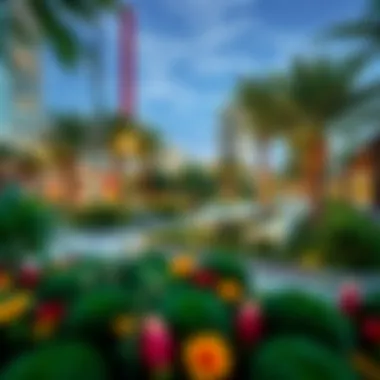
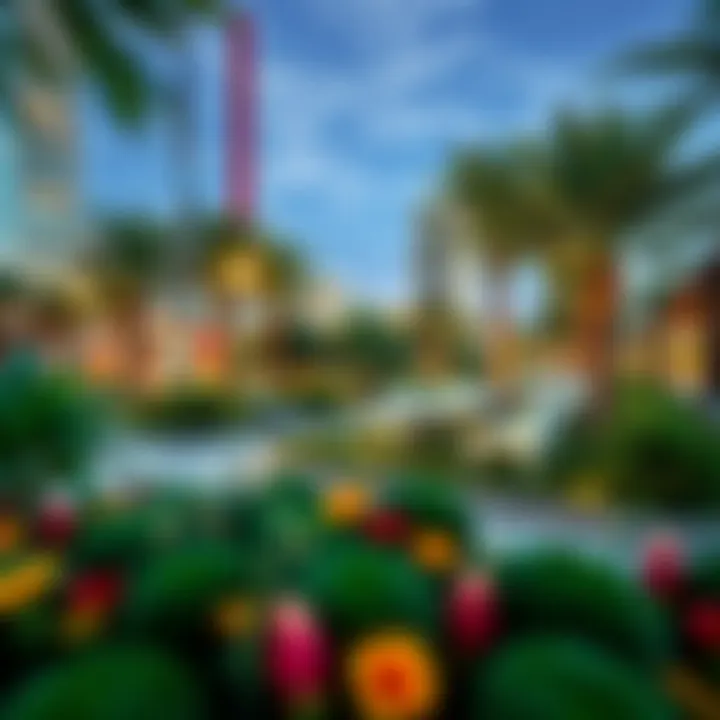
With this groundwork laid, it becomes apparent why public parks are both a communal asset and a challenge in this vibrant city. Finding solutions to these issues is crucial, as it reflects on the city's commitment to its residents and the environment.
Future Perspectives on Public Parks
Public parks are not merely patches of green in bustling urban environments; they are vital components of city life, especially in a unique setting like Dubai. With rapid urbanization and a constant influx of residents and tourists, the future perspective on public parks is crucial. Yes, it's about sustainability and preservation, but there's more to it. The future of these spaces calls for innovation, community engagement, and adaptive management to ensure they serve their intended purpose effectively.
Sustainability Initiatives
Sustainability is the backbone of future developments in public parks. In a city where the desert meets the skyline, establishing parks that harmonize with the environment is essential. Sustainable initiatives focus on low-impact development practices that reduce water consumption and maintain biodiversity. Here are some noteworthy aspects:
- Native Plant Usage: Employing plants that are indigenous to the region not only conserves water but also provides habitats for local wildlife. For instance, planting Ghaf trees can help restore natural ecosystems.
- Water Management Systems: Implementing rainwater harvesting and irrigation systems that utilize recycled water ensures these green spaces remain lush without exhausting resources. Parks like Al Barsha Pond Park have started employing such technologies.
- Community Involvement: Engaging local volunteers in maintenance and clean-up efforts creates a sense of ownership. This model has been observed in various UAE parks, encouraging local participation while fostering community ties.
- Educational Programs: From tree planting to sustainability workshops, educating the public can ignite a passion for conservation. Programs tailored for schools can teach children the importance of maintaining green spaces.
"Parks are the lungs of our cities; we must nurture them to breathe life into our communities."
Technological Integration
As we navigate the increasingly digital world, technological integration in public parks emerges as a game changer. Technology can enhance the user experience, making these spaces more accessible and enjoyable. Consider the following elements:
- Smart Park Features: Integrating features such as free Wi-Fi, mobile apps for navigation, and interactive kiosks can greatly enhance the visitor experience. Parks in Dubai could benefit from systems that inform users about park events or available amenities, thus improving engagement.
- Data for Decision-Making: Using data analytics can help understand visitor trends and park performance. This can assist city planners in making informed decisions, ensuring resources are allocated effectively.
- Virtual Reality Experiences: Certain parks may offer virtual tours or educational AR apps that showcase the environment and its history. This not only attracts tech-savvy visitors but also provides learning opportunities.
- Sustainable Transportation: Encouraging the use of electric scooters or bicycles by providing charging stations and bike paths integrates eco-friendly transportation into the park experience, promoting an active lifestyle while reducing carbon footprints.
With these advancements, parks in Dubai can evolve into multifunctional spaces that cater to the needs of residents, expatriates, and tourists alike, addressing both recreational and ecological requirements. The future of public parks in Dubai thus hinges on how effectively we blend sustainability with technology – pioneering a new green era.
An Introspective Look on Community Engagement
Community engagement plays a vital role in shaping the experience of public parks in Dubai. It’s not just about having green spaces; it’s about how the community interacts with these spaces. Parks serve as a canvas for public expression, leisure, and social interaction. When local residents, expatriates, and even tourists take part in the development, maintenance, and use of public parks, they contribute to the vibrancy and relevance of those spaces. This section will delve into two primary aspects of community engagement: public participation in park design and volunteer programs and conservation efforts.
Public Participation in Park Design
The design of parks should reflect the needs and desires of the communities they serve. Engaging the public in park design leads to parks that not only meet aesthetic standards but also provide functional spaces that cater to the local populace. When community members have a say in what goes into their parks—be it play areas, sports facilities, or picnic spots—they feel a sense of ownership and pride.
In Dubai, several forums and initiatives encourage citizen involvement in park planning. For instance, community workshops allow residents to express their preferences. Through surveys and feedback mechanisms, designers can gain insightful perspectives. The result is often parks that feel tailored to the community's lifestyle.
Moreover, public participation can foster inclusivity. Different groups within the community, including families, children, and seniors, can voice their needs, leading to designs that consider accessibility, safety, and usability. This community-centered approach ensures spaces are not only well-used but also cherished.
Volunteer Programs and Conservation Efforts
Volunteer programs are another effective strand of community engagement. Such initiatives not only help in the maintenance and conservation of parks but also educate the community about sustainability. Numerous organizations in Dubai organize regular clean-up drives and tree-planting events, where volunteers from all walks of life come together. It’s a hands-on approach to caring for green spaces that enhances communal ties.
Participating in these volunteer programs allows residents to grasp the importance of environmental stewardship. They learn about local flora and fauna, the ecosystem’s role, and how their actions impact the environment. Volunteer activities often culminate in community gathering events, further reinforcing social bonds.
"Engaging the community in all aspects of park life ultimately cultivates a culture of care and responsibility, ensuring that public parks are preserved for future generations."
In summary, focusing on community engagement in public parks in Dubai brings many benefits. Not only does it encourage a sense of ownership among residents, but it also helps create inclusive, engaging, and sustainable green spaces that reflect the urban fabric of the city.
Closure: The Importance of Public Parks
In the bustling city of Dubai, public parks stand as essential threads in the urban fabric. They play a multifaceted role, extending beyond mere aesthetic value or recreational hubs. Evaluating their importance involves examining their contributions to quality of life, community cohesion, and the vision for a greener future.
Impact on Quality of Life
Public parks significantly enhance the quality of life for residents and visitors alike. They provide a sanctuary from the city's hustle and bustle, offering spaces for relaxation and reflection. Here, one can retreat from the heat—not just physically but mentally, too. These green spaces foster a sense of well-being through the presence of greenery and open air, encouraging outdoor activities, which are vital for maintaining both physical and mental health.
A walk through Al Barsha Pond Park, for instance, can act as a reminder that nature and nourishment are intertwined. Access to parks encourages families to engage in recreational activities, promoting physical fitness and reducing stress levels. It offers children a natural playground for creativity—climbing trees, exploring trails, and participating in community events. The combination of these elements contributes to a more harmonious community, where social interactions are encouraged through shared experiences.
Moreover, public parks like those in Jumeirah Beach Residence serve as venues for community events, connecting people from various backgrounds and fostering inclusivity. As they say, "It takes a village," and these parks indeed create neighborhoods that thrive on shared spaces. The community becomes enriched when individuals gather, whether for a weekend picnic or a morning yoga class, transforming parks into lively centers.
Vision for Dubai’s Green Spaces
The vision for Dubai’s green spaces extends well beyond the immediate needs of today. There's an understanding that as the city continues to develop, the demand for green, accessible areas will grow too. This forward-thinking approach is vital in combating urbanization's impacts—climate change, air quality deterioration, and loss of biodiversity.
One pivotal aspect includes integrating sustainability into park design and development. The introduction of native plants and ecosystems can significantly enhance the resilience of these spaces. Furthermore, investing in sustainable technologies, such as solar-powered lighting and rainwater harvesting systems, reflects a commitment to ecological stewardship. The vision aims not only to beautify the city but also to create dynamic ecosystems that support wildlife and enhance biodiversity within the urban landscape.
A notable example of such ambition is the Dubai Green Framework, initiated by the Dubai Municipality, which strives to increase green cover across the emirate. This indicates an understanding that public parks are not just parks; they are crucial players in climate adaptation and urban heat mitigation strategies. By prioritizing green space, Dubai is setting a precedent for future urban sustainability efforts.
"Green spaces are not just about plants and trees; they are about people and communities."



